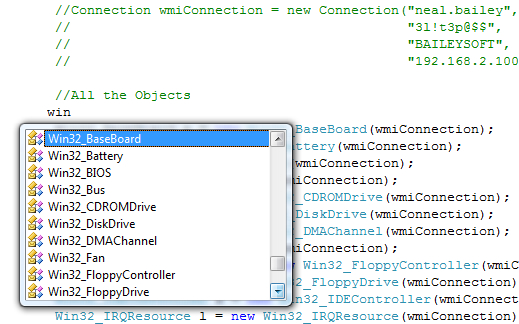How To: (Almost) Everything In WMI via C# - Part 3: Hardware
4.67/5 (42 votes)
An Extensible Framework for enumerating WMI Class Properties

Introduction
This is the third article in the series of articles How To: (Almost) Everything In WMI via C#.
- Reference Part 1: WIN32_Registry
- Reference Part 2: WIN32_Process
- Reference Part 3: Hardware Property Aggregation
In this article, I'm going to introduce a simple framework that can be used to aggregate property values for any of the hundreds of classes in the WMI namespace. In the attached example, I have included 30+ hardware classes used for everything from enumerating properties on network client CDRom disk drives to USB Host Controllers. When it comes to probing machines on the network for very detailed hardware information, nothing on the street can compare with WMI.
In the previous additions, we focused on a way to provide the property values as well as executing WMI methods. In this article however, we are going to focus on the considerable wealth of knowledge we can obtain by the properties alone.
Included Classes
The following included classes will return a collection of all the properties and values. This only applies to single string attributes. If you're going to need to aggregate multistring[] attribute values, then you'll need to wrap that in addition. Noticeably absent from this class listing is Win32_Printer, which I have left out since it deserves its own article.
Win32_BaseBoard: Mother board or System BoardWin32_Battery: System BatteryWin32_BIOS: System BIOSWin32_Bus: Physical System BusWin32_CDROMDrive: System Optical DrivesWin32_DiskDrive: System DisksWin32_DMAChannel: System DMA ChannelsWin32_Fan: System FanWin32_FloppyController: System Floppy ControllersWin32_FloppyDrive: System Floppy DrivesWin32_IDEController: System IDE ControllersWin32_IRQResource: System IRQ ResourcesWin32_Keyboard: System KeyboardWin32_MemoryDevice: System MemoryWin32_NetworkAdapter: Network AdaptersWin32_NetworkAdapterConfiguration: Adapter configurationWin32_OnBoardDevice: Common Devices built into the System boardWin32_ParallelPort: The Parallel portsWin32_PCMCIAController: The PCMCIA Laptop busWin32_PhysicalMedia: Storage Media such as tapes, etc.Win32_PhysicalMemory: The physical memory deviceWin32_PortConnector: Physical ports such as DB-25 pin male, PS/2, etc.Win32_Bus: Physical System BusWin32_PortResource: I/O ports on a systemWin32_POTSModem: Plain Old Telephone System Modem DevicesWin32_Processor: Processor specificationsWin32_SCSIController: System SCSI busWin32_SerialPorts: Serial PortsWin32_SerialPortConfiguration: Port ConfigurationWin32_SoundDevice: Sound DevicesWin32_SystemEnclosure: System DetailsWin32_TapeDrive: Physical Tape DrivesWin32_TemperatureProbe: Heat StatisticsWin32_UninterruptiblePowerSupply: UPS detailsWin32_USBController: USB Controller on a systemWin32_USBHub: USB HubWin32_VideoController: Physical Video ControllerWin32_VoltageProbe: Voltage Statistics
Using the Attached Code
Methods (Local Machine or Remote Machine)
GetPropertyValues()- Gets theWMIClass Properties values of the object
Instantiate the Local Provider
//Local Connection
Connection wmiConnection = new Connection();
Instantiate the Remote Provider
//Remote Connection
//Requires UserName, Password, Domain, and Machine Name
Connection wmiConnection = new Connection("neal.bailey",
"3l!t3p@$$",
"BAILEYSOFT",
"192.168.2.100");
Using the Classes
Using the classes is very simple. You just create a new instance of the WMI connection and then send the connection object into the WMI class you want to use. All the classes have the single method GetPropertyValues().
Connection wmiConnection = new Connection(); //The local or remote connection object
Win32_Battery b = new Win32_Battery(wmiConnection); //Create the WMI Class you want
foreach (string property in b.GetPropertyValues()) //enumerate the collection
{
Console.WriteLine(property);
}
Extending To Add Your Own WMI Classes
This solution is a simple framework that anyone can use to add and remove the WMI classes they need to enumerate.
Step One: Find some classes you want from the Microsoft WMI SDK.
Step Two: Create a class with the same name as the WMI class (example Win32_Printer) and paste the following code into it:
using System;
using System.Collections.Generic;
using System.Text;
namespace baileysoft.Wmi
{
class Win32_Printer : IWMI //The class name is the ONLY part that changes
{
Connection WMIConnection;
//The class name is the ONLY part that changes
public Win32_Printer(Connection WMIConnection)
{
this.WMIConnection = WMIConnection;
}
public IList{string} GetPropertyValues() //replace curly braces with <>
{
string className = System.Text.RegularExpressions.Regex.Match(
this.GetType().ToString(), "Win32_.*").Value;
return WMIReader.GetPropertyValues(WMIConnection,
"SELECT * FROM " + className,
className);
}
}
}
Step Three: Create a new tag in the settings.xml file for your class and enter the properties you want to enumerate (those ones in the SDK). Refer to the settings.xml file for the existing examples.
Conclusion
The WMI (Windows Management Instrumentation) provider is considerably slower than the native .NET classes and it may be easier to do this all with .NET classes but there are a lot of commercial solutions out there that do this exact same thing and surprise, surprise they use WMI for it. The included example solution demonstrates how to create a very powerful, extensible WMI hardware management solution.
History
- Submitted: 03 April, 2007
- Fixed formatting and grammar: 04 April, 2007
